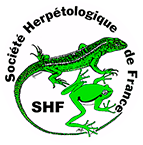The project team
The project team consists of a coordinating beneficiary, the Société Herpétologique de France, and seven associated beneficiaries.
The coordinating beneficiary is the project’s main structure, directly linked to the European Commission. Associated beneficiaries participate technically in the project, contributing to the implementation of the actions on their territory. Coordinating beneficiary and associated beneficiaries also participate financially in the project.
Société Herpétologique de France
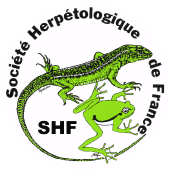 The Société Herpétologique de France (SHF) is an association founded in 1971 and approved by the Ministry of the Environment since 1978. It is also a member of the French Federation of Natural Science Societies (FFSSN) and, through it, of the International Union for Conservation of Nature (IUCN). The objectives of SHF is to facilitate relations between herpetologists, better make known Reptiles, Amphibians and their role in natural balances, contribute to a better knowledge of French fauna and its distribution, protect different species and their environment and improve the breeding conditions of Reptiles and Amphibians, especially for scientific purposes. SHF is the national interlocutor for managers of natural areas on many topics including invasive alien species.
The Société Herpétologique de France (SHF) is an association founded in 1971 and approved by the Ministry of the Environment since 1978. It is also a member of the French Federation of Natural Science Societies (FFSSN) and, through it, of the International Union for Conservation of Nature (IUCN). The objectives of SHF is to facilitate relations between herpetologists, better make known Reptiles, Amphibians and their role in natural balances, contribute to a better knowledge of French fauna and its distribution, protect different species and their environment and improve the breeding conditions of Reptiles and Amphibians, especially for scientific purposes. SHF is the national interlocutor for managers of natural areas on many topics including invasive alien species.
In the LIFE CROAA project, its mission is to coordinate all the associated beneficiaries and ensure that the project is well progressing. It is responsible of networking actors at the national level, developing tools for early detection and evaluation, communication and awareness-raising. It is also involved in other actions, in partnership with the associated beneficiaries.
Read more about SHF: lashf.org
Cistude Nature
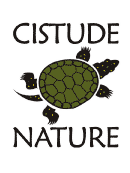 Cistude Nature is an association of nature protection of the Nature. It is located in Le Haillan, Gironde.
Cistude Nature is an association of nature protection of the Nature. It is located in Le Haillan, Gironde.
Cistude Nature has worked for more than ten years on invasive alien vertebrates. It carried out a program for the implementation of a plan of the Bullfrog eradication between 2003 and 2007. Since then, it has worked regularly on this issue, always on the Bullfrog, but also on the issue of exotic turtles and, more recently, exotic mammals.
In the LIFE CROAA project, Cistude Nature is responsible of the implementation of control actions against the Bullfrog on the main nuclei located in Gironde. An update of the settlement front is planned at the beginning of the project. Cistude Nature will also participate in the experimentation of new control techniques, in the evaluation of the strategies adopted during the program, and in communication and awareness-raising activities.
Read more about Cistude Nature: www.cistude.org
Comité Départemental de Protection de la Nature et de l’Environnement
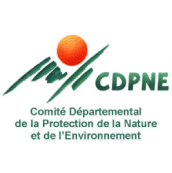 The CDPNE is an association of protection of the nature located in Blois, in Loir-et-Cher.
The CDPNE is an association of protection of the nature located in Blois, in Loir-et-Cher.
It is at the origin of the discovery in 2002 of colonization of the Bullfrog in Sologne. Since 2003, it has coordinated and implemented a program for the eradication of the species in Sologne, in partnership with the SEBB (Syndicat d’Entretien du Bassin du Beuvron). Since its discovery, the Bullfrog has been identified from a total of 91 different aquatic sites. The actions implemented have greatly reduced the number of colonized sites (only 20 after the 2014 actions), the population density and the average adult weight (divided by 2.3). This work is carried out under the aegis of an independent scientific committee which, at the end of 2014, underlines “the quality and investment of the partners in this program. The absence of newly colonized sites in 2014 is a particularly convincing result in the direction of progress towards eradication. The confirmation of the eradication of the species on sites formerly colonized shows that it is on objective achievable on the whole area colonized in Sologne.”
In the LIFE CROAA project, the CDPNE associate with the SEBB (represented as a project stakeholder) to continue and reinforce the action plan on the Bullfrog already in place. The agents of the SEBB participate in the eradication actions. The objective of the CDPNE is to achieve complete eradication of the species in Sologne. It participates in the development of new control techniques and the evaluation of the effectiveness of the actions implemented during the project. It is also responsible for communication activities on its territory.
Read more about CDPNE: www.cdpne.org
Communauté de Communes du Thouarsais
 Created on December 1998, the CCT is a public establishment of inter-municipal cooperation located in the North-East of the department of Deux-Sèvres.
Created on December 1998, the CCT is a public establishment of inter-municipal cooperation located in the North-East of the department of Deux-Sèvres.
The Communauté de Communes du Thouarsais has a service dedicated to the conservation of the natural heritage. In addition to the management of the Réserve Naturelle Nationale du Toarcien and the Centre d’interprétation Géologique du Thouarsais, four Espaces Naturels Sensibles (ENS), this service is involved in the fight against invasive alien species.
In particular, since January 2014, a technician is responsible for implementing a plan to fight against the African clawed frog. Based on the trapping of ponds using baited creels, this plan, which relies on a network of volunteers, demarcated the colonization front of the species in the southern part of the territory.
In the LIFE CROAA project, the Communauté de Communes du Thouarsais is responsible for the implementation of the actions against the African clawed frog in Deux-Sèvres and Vienne. An updating of the settlement front is necessary at the beginning of the project. The Communauté de Communes du Thouarsais contribute to the experimentation of new techniques of trapping in the field and will apply the strategies that will have been developed at the beginning of the program. It also participates in the evaluation of the actions implemented.
Read more about CCT: www.thouars-communaute.fr
Parc Naturel Régional Loire-Anjou-Touraine
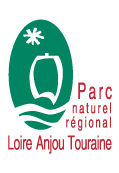 Created in 1996, the PNR Loire-Anjou-Touraine gathers 141 municipalities committed in a project that preserves natural heritage and enhances local resources.
Created in 1996, the PNR Loire-Anjou-Touraine gathers 141 municipalities committed in a project that preserves natural heritage and enhances local resources.
It is particularly attached to manage harmoniously its natural areas, to maintain the biological diversity of its environments and to preserve and enhance of its natural resources, landscapes and remarkable and fragile sites.
Many towns of the park are affected by the colonization of the African clawed frog. The Parc Naturel Régional Loire-Anjou-Touraine wishes to be involved in the fight against this species, which jeopardizes the natural balances of the remarkable wetlands of its territory.
In the LIFE CROAA project, the PNR Loire-Anjou-Touraine participates in the updating of the African clawed frog settlement front in Maine-et-Loire and Indre-et-Loire. It is responsible for the actions implementation to control this species in these two departments. It collaborates with all the other beneficiaries in the experimentation of new techniques for the control of invasive alien Amphibians and is involved in assessment of the strategies and methods implemented during the project.
Read more about the PBR Loire-Anjou-Touraine: www.parc-loire-anjou-touraine.fr
Parc Naturel Régional Landes de Gascogne
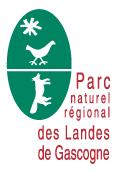 The PNR des Landes de Gascogne created in 1970. In 2006, in the framework of the study initiated by Cistude Nature on the Bullfrog, it carried out an inventory of Amphibians on its territory and Identified the Bullfrog nucleus of the Leyre valley.
The PNR des Landes de Gascogne created in 1970. In 2006, in the framework of the study initiated by Cistude Nature on the Bullfrog, it carried out an inventory of Amphibians on its territory and Identified the Bullfrog nucleus of the Leyre valley.
In the LIFE CROAA project, the Parc Naturel Régional des Landes de Gascogne is responsible for study the distribution of the species. It implements eradication measures. It also participates in the experimentation of new control techniques, the evaluation of strategies adopted during the program, and communication and awareness-raising activities.
Read more about the PNR des Landes de Gascogne: www.parc-landes-de-gascogne.fr
Parc Naturel Régional Périgord-Limousin
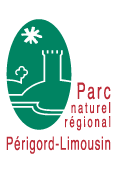 The PNR Périgord-Limousin created in 1998.
The PNR Périgord-Limousin created in 1998.
Concerning the management of invasive species, the Parc PNR Périgord-Limousin has implemented a pilot program for the eradication of the Bullfrog. Started in 2005, this program has identified nearly 54 ponds colonized by the Bullfrog. The Parc Naturel Régional Périgord-Limousin wished the eradication of the species. The methods that have been implemented each year include diurnal and nocturnal shooting, tadpole trapping and clutch detection. Today, there are only about 15 colonized sites in the park.
In the LIFE CROAA project, the Parc Naturel Régional Périgord-Limousin reinforces its action plan with greater technical, human and financial resources. The objective is to achieve eradication, after almost ten years of fight. In concrete terms, it is continuing the main actions of its current fighting rifle shooting, egg sampling, setting up of dispersal barriers, etc.), after updating the distribution of the species, and integrates the new techniques. It also participates in the evaluation of strategies adopted during the program and in communication and awareness-raising activities.
Read more about the PNR Périgord-Limousin: www.pnr-perigord-limousin.fr
Université d’Angers
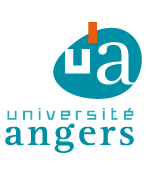 The University of Angers is a French public university. The GECCO (Ecology and Conservation of Vertebrates Group) is one of the laboratories of the University of Angers, whose a part of research deals with Amphibians and their conservation.
The University of Angers is a French public university. The GECCO (Ecology and Conservation of Vertebrates Group) is one of the laboratories of the University of Angers, whose a part of research deals with Amphibians and their conservation.
Jean Secondi is a researcher at the University of Angers and a member of GECCO. He will coordinate the research activities of the project. For 4 years, he has been involved in the elaboration of the interregional network of actors for the fight against the African clawed frog. He also initiated research activities on African clawed frog. He is currently co-supervising a thesis on this species carried out within the framework of the Invaxen project (European program Biodiversa) and experimented the method of detection by environmental DNA on this species. In addition, it has already collaborated with the scientific partners involved in the project.
In the LIFE CROAA project, the University of Angers is responsible for applied research activities, the aim is to identify a strategy for the control of the largest nuclei of invasive alien Amphibians. It also plays the role of scientific referent for all actions, including experimentation of new control techniques. It also participates in communication activities, notably through the publication of scientific articles and the organization of a scientific seminar.
Read more about the University of Angers: www.univ-angers.fr

